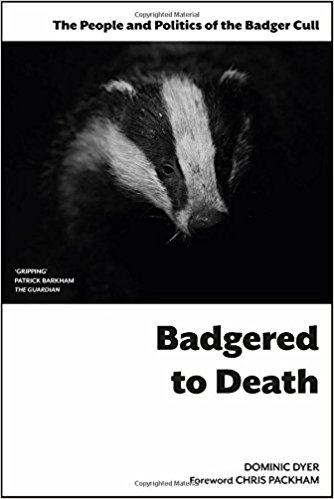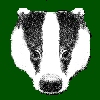 |
Detailed Badger Sounds

Introduction
There are various researchers who record badger
sounds to an unprecedented degree; and analyse their exact tones
and pitches to decipher meanings. In other words, to the
lay-person, these clever researchers try to understand badger
"language". Of course, some badger talk might seem
obvious to the ordinary badger-watcher - two badgers involved in a
serious fight, both making "growling" noises; the growl
is clearly an aggressive part of the badgers range of dialog.
However, not all such sounds are so clear; and one
badger may use a series of different sounds within the context of
a single overall message. For example, when cubs are engaged in
play-fighting (or where there is great excitement in the clan)
there may be a whole range of noises which merge together in quick
succession.
As many badger watchers view in conditions of near
darkness (where it is difficult to see what the badgers are doing
at all times) many would like to know what badgers are trying to
say to one another. Hopefully these short descriptions of the
various sound types will help you out a little.
Remember though that badgers also have a very good
sense of smell and certainly use distinct body-language to aid
communication. The overall "message" from one badger to
another is a combination of sound, smell and body language.
Importantly too, badger society has a certain hierarchy (with
top-, middle- and lower-ranking badgers). If you make a close
study of a single badger clan you will probably find that it tends
to be the more senior members of the badger clan who are the most
aggressive.
The Real Experts
To help you out, we give a short summary of some
badger sounds with a link to where you can hear them. We do not
provide the sounds themselves on www.badgerland.co.uk
, but instead link to the sound files stored on the following
web-site:
or here:
This linked web-site (part of Oxford University)
includes detailed explanations about badger sounds, as well as
providing software for analysing them.
Who Says What
The badger's vocal repertoire consists of at least
sixteen discrete calls, varying from long, low pitched growls to
short, high-pitched squeaks and bird-like coos.
Churrs, purrs, and keckers seem to be restricted
to adults only, while chirps, clucks, coos, squeaks and wails are
confined to the badger cub's repertoire. The remaining calls may
be expressed by both adults and cubs.
The most easily distinguished discrete calls are
the churr, growl, kecker, yelp and the wail - others are distinct,
discrete calls but show structural similarities to these five call
types.
During the mating season the most frequently heard
calls are the male churrs and the female yelps.
Badger Sounds and Call Descriptions
Calls can be played back by clicking on their
names (in the left-hand column below).
| SOUND: |
DESCRIPTION: |
|
The
Churr |
The Churr is essentially a
mating call. It is an 'insistent, deep, throaty, vibrant
purr with an oily, bubbling quality'. It has structural
similarity to the female purr. |
| The
Purr |
The Purr is similar to the
Churr, but softer and less intense. Both calls are
specific to the mother and directed solely towards her
offspring. The purr may be used when grooming or carrying
the cubs, to call cubs from the sett, or to encourage the
cubs to follow and stay close. |
| The
Wail |
The Wail is the call of an
infant in distress, usually when the cub is isolated from
the mother. As infant distress increases, so does the
intensity and rate of wailing. |
| The
Chitter |
The Chitter is a relatively
short, high-pitched, querulous chatter.
Adult chitter is used in the context of pain / fear and
frustration / anxiousness. The chitter is often used by
the female, either when she is being harassed by a male
intending to mate, or to signal pain or fear during
mating. In cubs it is heard mainly during excited social
play.
A gentle variant of the Chitter is the call referred to
as the "Whicker", a sound like the whinny of the
horse often used in situations of mild frustration.
|
| The
Kecker |
The Kecker is a relatively
long, single sound, similar in structure to the Chitter.
This call is used primarily in the contexts of
threat/submission, attack and fighting. As fighting
becomes more serious, the intensity, emission rate and
amplitude of intermittent keckering may increase. |
| The
Growl |
Growls are low-pitched,
rumbling sounds which are sustained and coarse. The growl
is the longest badger sound. The growl is associated with
warning or defence, produced most commonly by adults in
the presence of food or young, or when an unfamiliar
individual enters the territory. It usually serves to
elicit a retreat on the part of the receiver. |
| The
Snarl |
Snarls are moderate pitched,
single, sounds - usually over a second in duration. This
call is used primarily in the threat/attack context and,
unlike the growl, almost always precedes attack. Such
calls are often nearly simultaneous between individuals
involved in high intensity aggression. |
| The
Yelp |
Adult yelps are given mostly in
series, and are often heard in sequence with chitters. The
yelp is used primarily in the context of pain and/or fear,
being employed to signal actual pain or perhaps fear in
anticipation of pain. In adults it is most commonly used
by females before and/or during mating. |
| The
Squeak |
The squeak is a very short,
shrill, high-pitched call, similar to the yelp. The cub
squeak is found in the context of frustration and
anxiousness, when the cub is separated from its mother, or
in play. |
| The
Bark |
The Bark resembles the bark of
a small dog. The bark is usually heard during play, or in
the startle/surprise and warning/defence contexts. Barking
in adults functions primarily to warn off an approaching
badger. The bark may also be heard during mating, when
either one of badger is being annoyed by another. |
| The
Snort |
Snorts are used only in the
startle / surprise context, and is most commonly elicited
when one badger is surprised by another. The surprised
badger may jump back. The snort may be used to startle a
potential predator. |
| The
Cluck |
Restricted to cubs, the cluck
is a bird-like sound, resembling the soft quacks of ducks.
The cluck is heard during greeting, grooming, and play,
and is associated with close contact. |
| The
Coo |
The coo is an extremely soft,
dove-like call that is usually heard in isolation. The coo
is a close range contact call of the cub. |
| The
Chirp |
Chirps have only been heard
from cubs. They are moderate-pitched, soft, bird-like
sounds. They are single, short sounds, usually heard in
series. |
| The
Hiss |
Hisses are unvoiced, sharp,
cat-like sounds. They are emitted in isolation, with
growls and snarls primarily in the context of warning or
defence. They often intimidate the recipient. |
| The
Grunt |
The grunt is a relatively
short, low pitched, blunt sound. Unlike the adult grunt,
cub grunts are sometimes used in series. This call is
associated with close contact - such as grooming.
|

| Badger Volunteers? |
| The WildCRU at Oxford University often need people to help
do badger surveys.
You can work with some of the best badger researchers in the UK AND learn about
our favourite wild mammal.
|
| For more info, click Jobs at the WildCRU.
|
 |
| Badgered to Death |
 |
Dom Dyer's polemic on the toxic mix of farming, lobbying and politics and how fake-science lead to badger culls in England. Click here to buy:
Paperback edition
|
|
